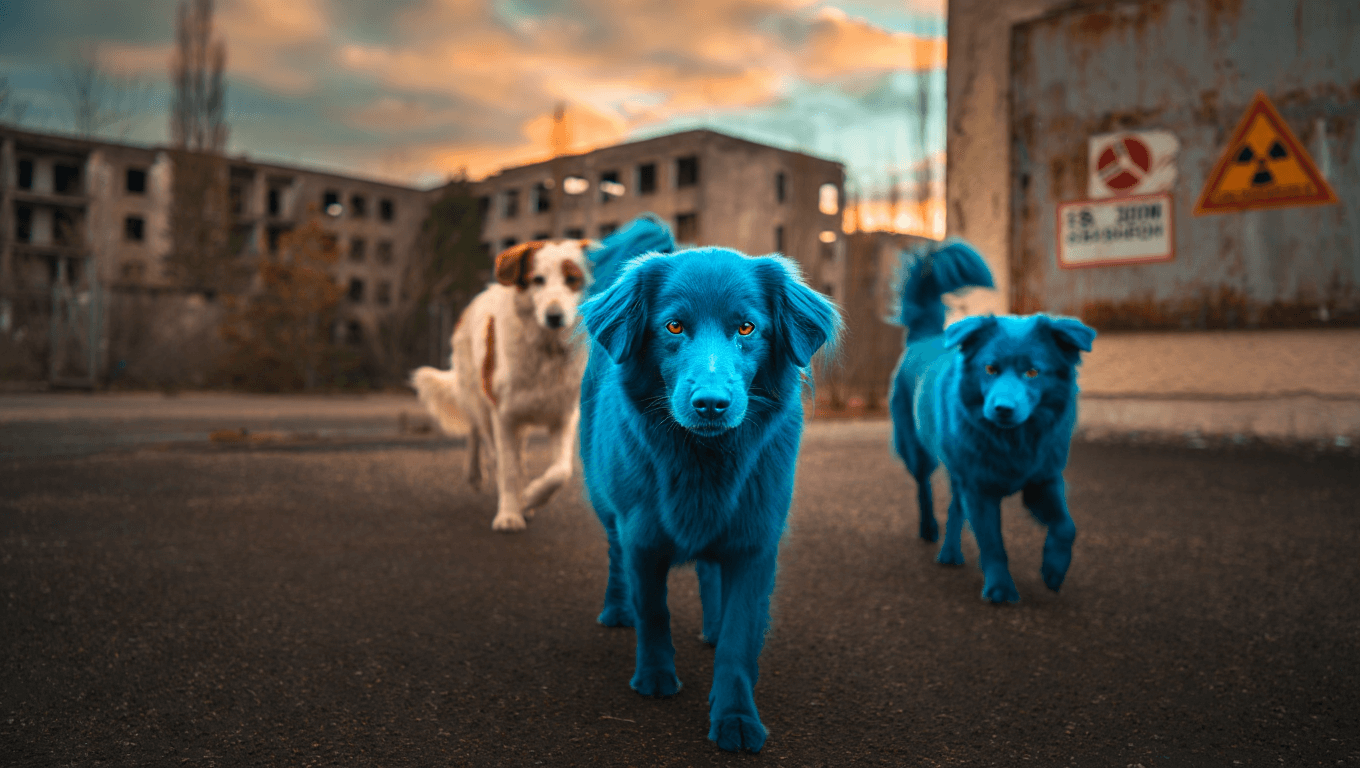For weeks, viral images showed three stray dogs with bright blue fur roaming the Chernobyl Exclusion Zone. The Clean Futures Fund shared the mysterious photos on October 6, 2025. Millions of people feared radiation exposure or AI trickery. A veterinarian finally cracked the case: porta-potty dye.
Pluto TV’s Hidden Movie Section Rivals Premium Services
Korean Netflix Has 200+ Shows US Version Doesn’t Stream
🔥 Quick Facts:
- Spotted: Three blue dogs discovered at Chernobyl on Oct. 6, 2025
- Cause Revealed: Portable toilet dye, not radiation exposure
- Expert: Jennifer Betz, veterinary director for Dogs of Chernobyl
- Area: 19-square-mile Chernobyl Exclusion Zone established in 1986
- Population: Approximately 250-500 stray dogs live throughout the zone
What Happened: Blue Dog Mystery Solved
The Dogs of Chernobyl team conducted a routine campaign from October 5-13, 2025. They worked to capture, sterilize, and release stray dogs. These dogs are descendants of pets abandoned during the 1986 evacuation. The team discovered three canines almost completely covered in bright blue fur.
Netflix reveals economics behind 3-season cancellations as viewership metrics drop
YouTube Premium Originals Nobody Talks About Are Award-Winning
Jennifer Betz, the veterinary medical director, confirmed the findings. She explained they attempted multiple times to catch the dogs. These particular animals are extremely fearful of people and require specialized dart equipment. The team wasn’t successful this time around.
“We are suspecting that this substance was from an old portable toilet that was in the same location as the dogs. However, we were unable to positively confirm our suspicions.”
The blue dye used in portable toilets is harmless to animals. The dogs likely rolled around in old, leaking toilet chemicals. The substance caused no apparent harm to the canines. The team emphasized this wasn’t radiation-related contamination.
Why This Matters: Debunking Wild Theories Fast
Social media exploded with wild speculation about the blue dogs. Some people claimed the photos were AI-generated or heavily filtered. Others expressed genuine concern about catastrophic radiation poisoning. The mystery sparked thousands of posts across Instagram, TikTok, and Reddit.
The quick scientific explanation calmed public fears immediately. Betz stressed the finding poses zero danger to animal populations. She emphasized, “I would suspect, as long as they don’t lick the majority of the substance off of their fur, it would be mostly harmless.” This reassurance prevented unnecessary alarm spreading globally.
The incident highlights how quickly misinformation spreads online. A single unusual image can trigger panic without context. Expert explanations grounded in veterinary science proved invaluable. The discovery also showcased the legitimate work being done at Chernobyl by animal welfare organizations.
The Details: Blue Dye vs. Sterilization Markers
Interestingly, the Dogs of Chernobyl program already uses blue markers for sterilization tracking. However, it’s completely different from the blue fur discovery.
| Sterilization Marker | Porta-Potty Dye |
| Crayon marker (green, red, blue, purple) | Chemical blue dye used in portable toilets |
| Applied on top of head only | Dogs roll in it, covering entire body |
| Washes off within days | Requires extended contact to cause visible coloring |
| Purpose: Identify recently sterilized dogs | Result: Accidental chemical contact from environment |
The program has sterilized over 1,000 dogs and cats since 2017. The Clean Futures Fund estimates roughly 250 stray dogs live around the nuclear power plant. Hundreds more roam throughout the exclusion zone’s nearly 19-square-mile radius. All dogs appear healthy and show no signs of radiation exposure.
What To Watch For: Future Discoveries Ahead
The Chernobyl dogs continue to surprise researchers and animal welfare teams:
- Ongoing sterilization campaigns to control stray populations humanely
- Health monitoring of dogs for any long-term radiation effects
- Genetic studies to understand adaptation after 39 years in the zone
- Public education efforts to separate fact from misinformation
- Potential rescue and adoption programs for select animals
The Dogs of Chernobyl initiative continues expanding its reach. Teams provide food, veterinary care, and population monitoring throughout the zone. This work protects both the animals and provides valuable scientific data about life post-disaster.
Are Blue Dogs Safe? What’s the Real Health Risk?
Yes, the blue dogs are safe. Porta-potty dye carries no known health hazards to animals. The substance is designed to be non-toxic, since it processes human waste. Rolling in it poses minimal danger compared to actual radiation exposure.
The sterilized dogs observed by the Dogs of Chernobyl team display healthy behavior. They’re active, eating normally, and showing no distress signals. Betz and her team found no alarming health indicators. The viral mystery ends with relief: nature and chemical happenstance, not nuclear catastrophe.
This incident reminds us that extraordinary claims demand extraordinary evidence. Science, expert consultation, and calm investigation solved the puzzle quickly. The real story here is positive: dedicated animal welfare workers protecting creatures in one of Earth’s most challenging environments.
Sources
- Newsweek – Interview with Jennifer Betz, veterinary medical director for Dogs of Chernobyl program
- Clean Futures Fund – Official discovery reports and animal welfare analysis
- Popular Mechanics – Investigation into chemical composition and scientific explanation

Daniel Harris is a specialist journalist focused on the crossroads of breaking news, extraordinary history, and enduring legends. With a background in historical research and storytelling, he blends timely reporting with timeless narratives, making complex events and ancient myths resonate with today’s readers. Daniel’s work often uncovers surprising links between present-day headlines and legendary tales, offering unique perspectives that captivate diverse audiences. Beyond reporting, he is passionate about preserving oral traditions and exploring how extraordinary stories continue to shape culture and identity.

